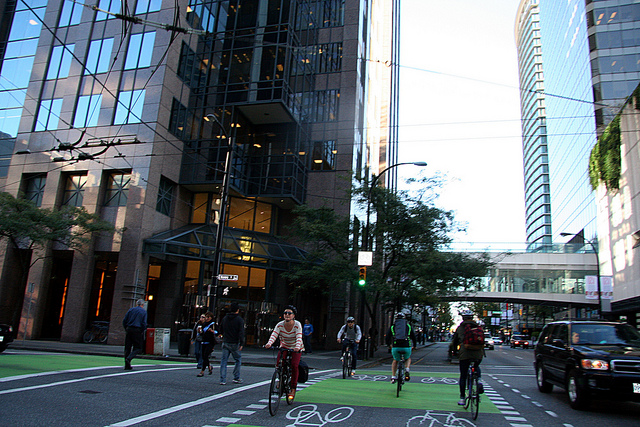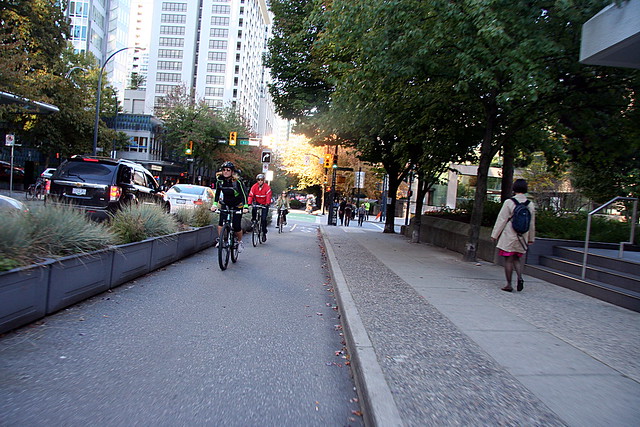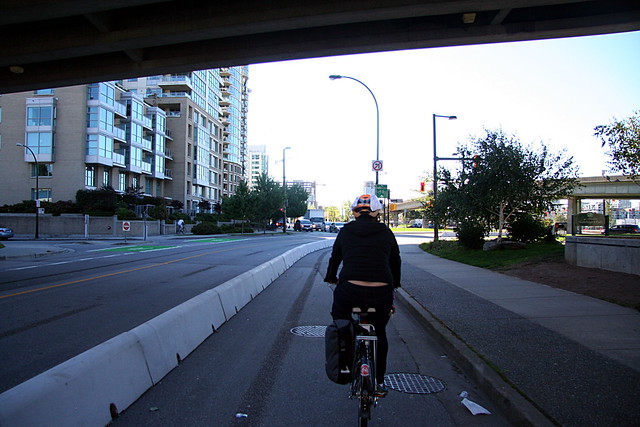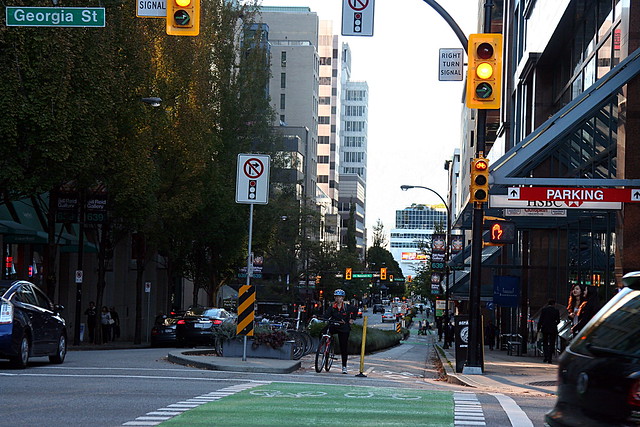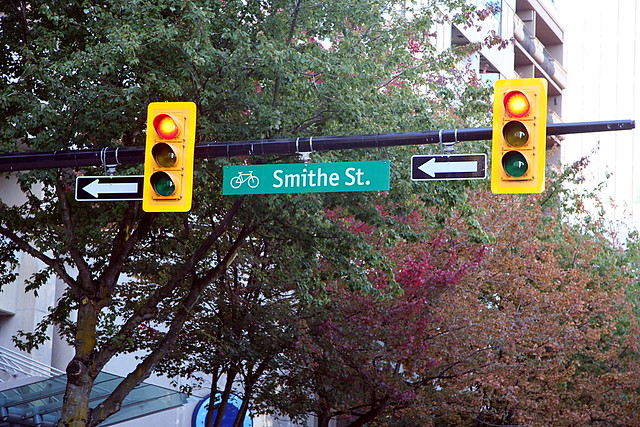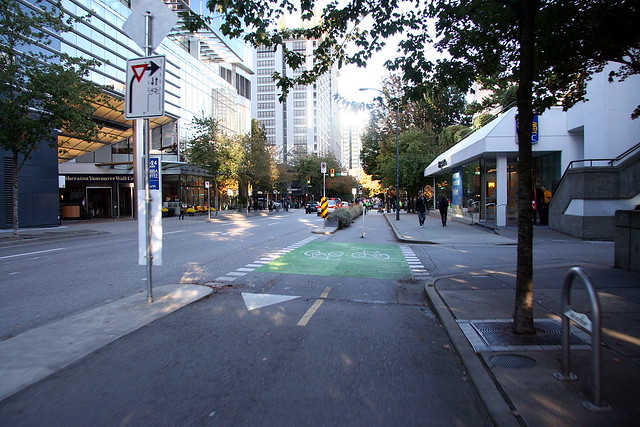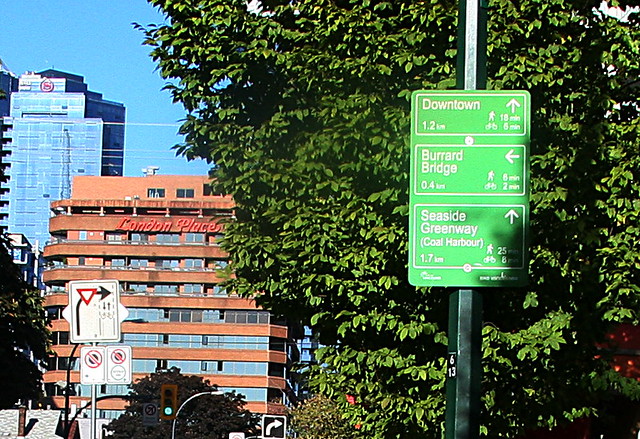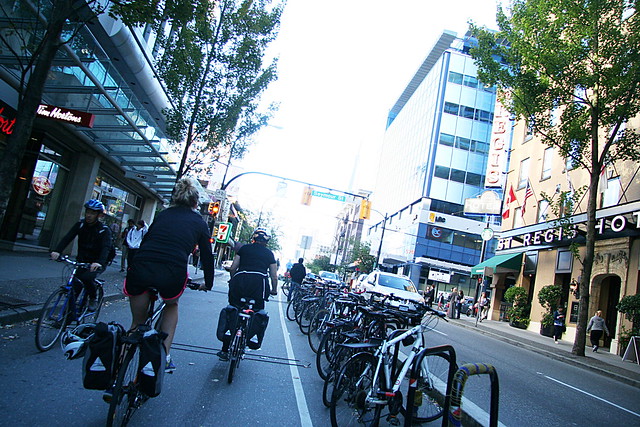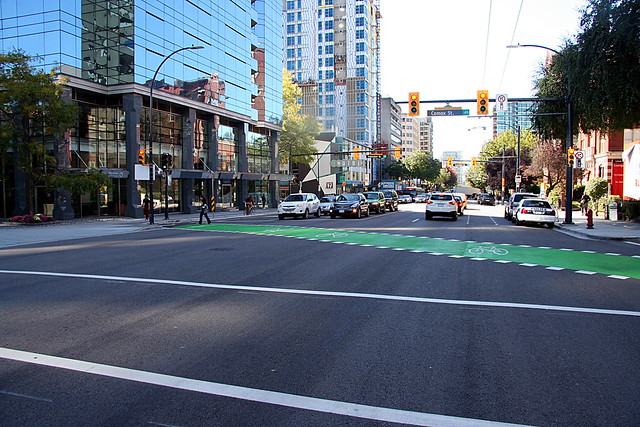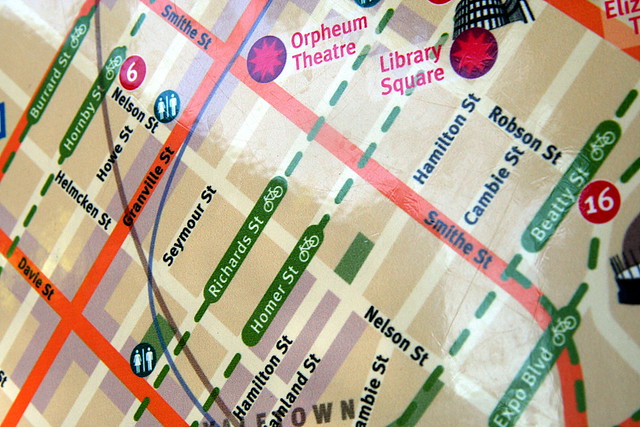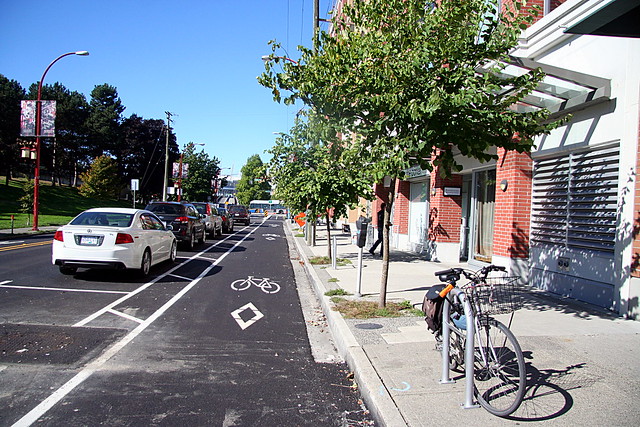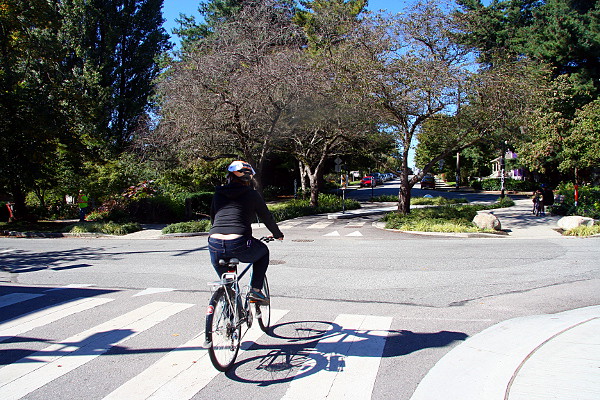Lots of people know you can go to Copenhagen or Manhattan to see grids of protected bike lanes in action. But there’s another set of them 300 miles north of Portland — and they run right through a city so similar to Portland that they could be siblings.
Stumptown could learn plenty of things from Vancouver B.C., where I spent two days last week. And our tall, skinny younger sister, which is almost exactly our size by population, could learn things from us, too.
But Vancouver is definitely ahead of our curve in one way: in the last few years, it built the simple network of physically separated downtown bikeways that Portland seems to be getting ready to install. Here’s what they look like, from the nitty-gritty to the grand.
1) Planter barriers in the highest-traffic areas…
The protected bike lanes in Washington DC and now Chicago are quick and cheap, made to cover lots of ground on a low budget: they use plastic bollards as separators. Portland’s newest one, on Northeast Multnomah, also has a nice set of huge round planters the city has had on hand for years. But my favorite barrier in Vancouver, above, was almost as thin as a row of bollards and much more attractive: a foot-wide row of planters with grassy bushes inside.
2) …and low concrete barriers farther out.
I’ve sometimes heard people talk about Jersey barriers to set off bike lanes, and imagined the huge hulking sort you see on highways. This photo, from just southeast of downtown proper, shows how neat and unobtrusive concrete can be while still keeping cars away on a local street.
3) Lots and lots of traffic signals.
Count them: The intersection above has three signals in the same direction, each set to a different phase (through-driving autos, right-turning autos, and bikes), and two “no turn on red” signs for good measure. Elegant? No. And on the two-way cycle tracks like this one, riding against auto traffic meant stopping almost every block, because the lights weren’t timed for you. Still, it did all seem to work.
4) Street-specific bike signage.
If Vancouver does one thing better than anywhere else I’ve ridden, it’s signs. This city is mad for signs, and I loved it. Not only does every bike boulevard have an officially designated name; every intersection of two bike boulevards near the central city seems to have a set of custom-printed signs that show which crossroads you’ve reached. But maybe my favorite detail of all was the bike marking on the auto-oriented street sign above — unquestionably indicating to people in cars that, next time they happen to be on a bike, Smithe would be one of the streets for them.
5) Painted midblock crossings.
Driveways are the enemy of the protected bike lane, because people in cars and on bikes don’t always think to look out for one another. If Portland ever puts protected lanes on Northeast Broadway or Southwest 4th, midblock driveways will be the biggest problem to solve. Here’s how Vancouver handles them: with dashed lines and lots and lots of green paint. (And, of course, a sign.)
6) Wayfinding signs everywhere.
This close-up of a combined bike-and-foot wayfinding sign is similar to the ones on Portland’s neighborhood greenways, but it includes walking, too. Honestly, this seems like a lot of information for a street sign.
7) Not nearly enough parking…
The worst thing about biking in Vancouver (or, worse still, in nearby Victoria BC) is the lack of public bike parking. British Columbia’s official bike education guide actually recommends locking bikes to parking meters or signposts, inviting bikes to teeter, slip and block sidewalks. Scenes like this (from Kitsilano, southwest of downtown) are rare in Portland now, but common in Vancouver.
8) …except when bike staples serve as separators.
Pretty efficient, right? Easy to see over, too.
9) Crossbikes.
You know — like crosswalks, except for bikes. This one cut diagonally across the intersection. I didn’t even try to figure out all the nuances of how these signals worked.
10) Bikeways on the downtown tourist maps.
Cities that are serious about making their bike networks legible should clearly mark their bike networks on every map posted on downtown sidewalks for use by tourists and newcomers. Here’s a detail shot from Vancouver’s.
11) A comfortable bridge out of downtown…
The Dunsmuir Viaduct, which crosses railroad tracks and other obstacles east of downtown Vancouver, is the comfortable, appealing bikeway that the Morrison Bridge’s separated bike lane wants to be. Unfortunately for Portlanders, the Morrison bikeway essentially dead-ends into Water Street and the truck-oriented Central Eastside, making it invisible to all but the savviest bikers.
12) …that almost seamlessly connects to a neighborhood greenway.
This parking-separated bikeway is the east landing of the Dunsmuir Viaduct that leads to downtown. It sort of looks like Southeast Hawthorne, if you were to squint … and then move the parked cars nine or 10 feet to the right.
A few blocks further east is one of the most impressive of Vancouver’s many wonderful traffic diverters, which protect its neighborhood greenways from becoming automotive shortcuts. This one doubles as a parklet — incuding a public bicycle pump.
Is Vancouver a bike paradise? Definitely not. Despite much more density, its bike commute rate is lower than Portland’s. In fact, I was surprised by how auto-oriented central Vancouver’s streets felt. They’re generally wider than Portland’s and regularly offer two auto travel lanes in each direction, a formula that invites cars to zoom between the skyscrapers and dart around one another at a bizarrely out-of-place 35 mph. Maybe this highway-style driving is a reaction to the city’s lack of urban freeways — it’s the largest in North America that doesn’t have any, thanks to successful activism in the 1960s.
But downtown Vancouver is now, compared to almost any other central city on the continent, a joy to get around on a bike. And if the result is anything other than a substantial increase in downtown Vancouver biking over the next three years, your next Japadog is on me.
— Hat tip to our friend (and valuable comment contributor here on BikePortland) Ted Buehler, whose Facebook comments about biking in Vancouver helped me know what to keep my eyes open for.
